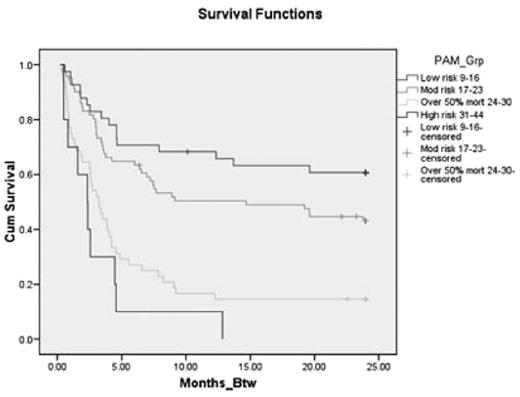Abstract
Mortality rates after allogeneic hematopoietic cell transplantation for hematological malignancies remains high. Recently, a 50-point pretransplantation assessment of mortality (PAM) score was developed by clinical investigators at the Fred Hutchison Cancer Research Center utilizing eight pre-transplant clinical variables including age, donor type, disease risk, conditioning regimen, percentage of predicted FEV1, percentage of predicted DLCO, serum creatinine level and serum ALT level. The PAM score performed well to predict risk of death in the first two years after allogeneic hematopoietic cell transplantation. The objective of our study was to validate the PAM score in a retrospective cohort of patients that underwent allogeneic hematopoietic cell transplantation at Hahnemann University Hospital from 1986 until 2006. 400 patients underwent allogeneic hematopoietic cell transplantation from 1986 to 2006. 170 patients were found to be eligible for retrospective analysis since pre- transplant serum alanine aminotransferase (ALT) levels were not available for the remaining 230 patients. The PAM score was calculated for each patient using the scoring system outlined in the original article. The patients were categorized into four cohorts with scores ranging from 9 to 16 for category 1 (probability of death, 25%), from 17 to 23 for category 2 (probability of death, 25% to 50%), from 24 to 30 for category 3 (probability of death, 50% to 75%), and from 31 to 44 for category 4 (probability of death, 75%). Kaplan- Meier survival curves were generated for each of the four categories. Overall mortality was 62.9% at 2 years. PAM scores ranged from 11 to 36. 41 patients were grouped into category 1, 71 into category 2, 48 patients into category 3 and 10 patients into category 4. Mortality at 2 years was 39% in category 1, 56.3% in category 2, 85.4% in category 3 and 100% in the high-risk category. Compared to the low risk group, group 2 had a hazard ratio of 1.64 (p = 0.092, CI: 0.92 to 2.94); group 3 had a hazard ratio of 3.996 compared to the low risk group (p < 0.001, CI: 2.23 to 7.16) and group 4 had a hazard ratio of 6.73 versus the low-risk group (p < 0.001, 95% CI: 3.01 to 15.04). In conclusion, the PAM score successfully classified patients into distinct survival groups (p < 0.001 for the comparison by log-rank test). Higher PAM scores were associated with progressively increased risk of death.
Author notes
Disclosure: No relevant conflicts of interest to declare.


This feature is available to Subscribers Only
Sign In or Create an Account Close Modal